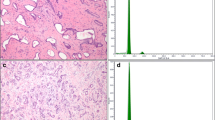Abstract
PURPOSE: To examine the prevalence of DNA aneuploidy as a function of the extent of ulcerative colitis and to study the correlation of aneuploidy with clinical characteristics. Furthermore, the occurrence of aneuploidy and dysplasia during colonoscopic surveillance was studied in a subset of these patients. METHODS: By analyzing 5404 biopsy samples of 368 patients with ulcerative colitis, we have evaluated the importance of DNA ploidy measured by flow cytometry. We have also investigated the influence of extent (219 patients with extensive or total colitisvs. 149 patients with localized colitis) and duration of colitis on the development of dysplasia (patients with biopsy specimens that showed inflammation alone were compared with those with biopsy specimens that were equivocal or positive for dysplasia) and aneuploidy. Included was a subgroup of patients with ulcerative colitis and primary sclerosing cholangitis (n=16). RESULTS: Aneuploidy was found in 8.7 percent (32/368) of all patients. The prevalence of aneuploidy increased by the extent of ulcerative colitis (2 percent localized, 6.8 percent extensive colitis, 14.9 percent total colitis). The frequency of aneuploidy was higher in patients with disease duration longer than 10 years (P=0.007). Patients with ulcerative colitis and primary sclerosing cholangitis were more likely to develop aneuploidy (9/16, 56.3 percentvs. 14/120, 11.7 percent;P<0.001) and dysplasia (4/16, 25 percentvs. 10/120, 8.3 percent;P=0.06) than patients without primary sclerosing cholangitis. CONCLUSION: Because DNA aneuploidy represents an early alteration during neoplastic transformation in ulcerative colitis, flow cytometry is a valuable tool in the surveillance of those patients. Primary sclerosing cholangitis represents an additional risk factor for the development of DNA aneuploidy and dysplasia.
Similar content being viewed by others
References
Porschen R, Strohmeyer G. Dysplasie und kolorektales Karzinomrisiko bei Colitis ulcerosa. Dtsch Med Wochenschr 1991;116:1682–8.
Riddell RH, Goldmann H, Ransohoff DF,et al. Dysplasia in inflammatory bowel disease: standardized classification with provisional clinical applications. Hum Pathol 1983;14:931–68.
Melville DM, Jass JR, Shepard NA,et al. Dysplasia and deoxyribonucleic acid aneuploidy in the assessment of precancerous changes in chronic ulcerative colitis: observer variation and correlations. Gastroenterology 1988;95:668–75.
Remvikos Y, Muleris M, Vielh PH, Salmon RJ, Dutrillaux B. DNA content and genetic evolution of human colorectal adenocarcinoma: a study by flow cytometry and cytogenetic analysis. Int J Cancer 1988;42:539–43.
Löfberg R, Tribukait B, Öst A, Brostrom O, Reichard H. Flow cytometric DNA analysis in longstanding ulcerative colitis: a method of prediction of dysplasia and carcinoma development? Gut 1987;28:1100–6.
Porschen R, Robin U, Schumacher A,et al. DNA aneuploidy in Crohn's disease and ulcerative colitis: results of a comparative flow cytometric study. Gut 1992;33:663–7.
Rutegard J, Ahsgren L, Stenling R, Roos G. DNA content in ulcerative colitis: flow cytometric analysis in a patient series from a defined area. Dis Colon Rectum 1988;31:710–5.
Vindelov LL, Christensen IJ, Nissen NI. A detergent-trypsin method for the preparation of nuclei for flow cytometric DNA analysis. Cytometry 1983;3:323–7.
Ekbom A, Helmick C, Zack M, Adami HO. Ulcerative colitis and colorectal cancer: a population-based study. N Engl J Med 1990;323:1228–33.
Hammarberg G, Slezak P, Tribukait B. Early detection of malignancy in ulcerative colitis: a flow-cytometric DNA study. Cancer 1984;53:291–5.
Löfberg R, Broström O, Karlen P, Tribukait B, Ost A. Colonoscopic surveillance in long-standing total ulcerative colitis: a 15-year follow-up study. Gastroenterology 1990;99:1021–31.
Fozard JB, Quirke P, Dixon MF, Giles GR, Bird CC. DNA aneuploidy in ulcerative colitis. Gut 1986;27:1414–8.
Rubin CE, Haggitt RC, Burmer GC,et al. DNA aneuploidy in colonic biopsies predicts future development of dysplasia in ulcerative colitis. Gastroenterology 1992;103:1611–20.
Löfberg R, Brostöm O, Karlen P, Ost A, Tribukait B. DNA aneuploidy in ulcerative colitis: reproducibility, topographic distribution, and relation to dysplasia. Gastroenterology 1992;102:1149–54.
Broome U, Löfberg R, Veress B, Eriksson LS. Primary sclerosing cholangitis and ulcerative colitis: evidence for increased neoplastic potential. Hepatology 1995;5:1404–8.
Broome U, Lindberg G, Löfberg R. Primary sclerosing cholangitis in ulcerative colitis: a risk factor for the development of dysplasia and DNA aneuploidy? Gastroenterology 1992;102:1877–80.
Nuako KW, Ahlquist DA, Sandborn WJ, Mahoney DW, Siems DM, Zinsmeister AR. Primary sclerosing cholangitis and colorectal carcinoma in patients with chronic ulcerative colitis. Cancer 1998;82:822–6.
Brentnall TA, Hagggitt RC, Rabinovitch PS,et al. Risk and natural history of colonic neoplasia in patients with primary sclerosing cholangitis and ulcerative colitis. Gastroenterology 1996;110:331–8.
D'Haens GR, Lashner BA, Hanauer SB. Pericholangitis and sclerosing cholangitis are risk factors for dysplasia and cancer in ulcerative colitis. Am J Gastroenterol 1993;88:1174–8.
Leidenius MH, Färkkilä MA, Kärkkäinen P, Taskinen EI, Kellokumpu IC, Hockerstedt KA. Colorectal dysplasia and carcinoma in patients with ulcerative colitis and primary sclerosing cholangitis. Scand J Gastroenterol 1997;32:706–11.
Vogelstein B, Fearon ER, Hamilton SR, Kern SE. Genetic alterations during colorectal tumor development. N Engl J Med 1988;319:207–11.
Holzmann K, Klump B, Borchard F,et al. Comparative analysis of histology, DNA content, p53 and Ki-ras mutations in colectomy specimens with long-standing ulcerative colitis. Int J Cancer 1998;76:1–6.
Author information
Authors and Affiliations
Additional information
Supported by Deutsche Krebshilfe (Contract Grant Number: M97/94/P4) and the Grimmke Foundation.
Dr. Klump is supported by the Deutsche Krebshilfe (70–260I) and the German Competence Network for Inflammatory Bowel Disease.
About this article
Cite this article
Holzmann, K., Klump, B., Borchard, F. et al. Flow cytometric and histologic evaluation in a large cohort of patients with ulcerative colitis: Correlation with clinical characteristics and impact on surveillance. Dis Colon Rectum 44, 1446–1455 (2001). https://doi.org/10.1007/BF02234596
Issue Date:
DOI: https://doi.org/10.1007/BF02234596




